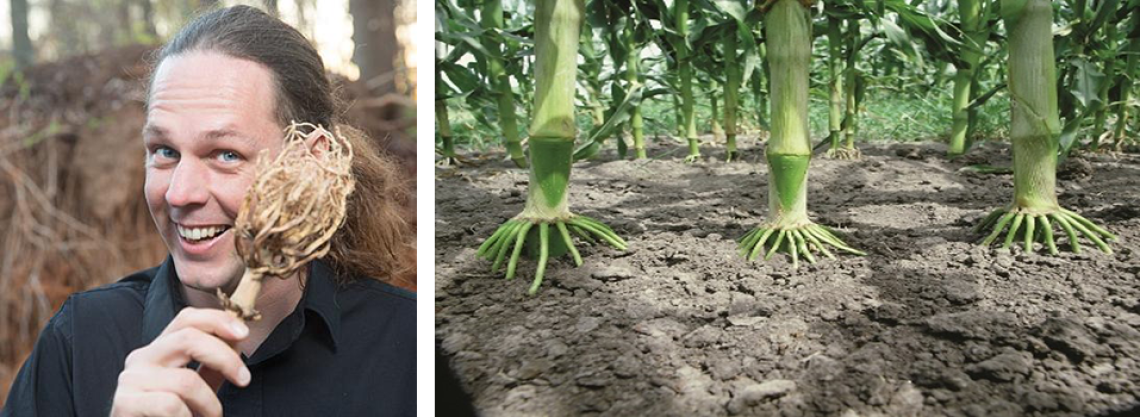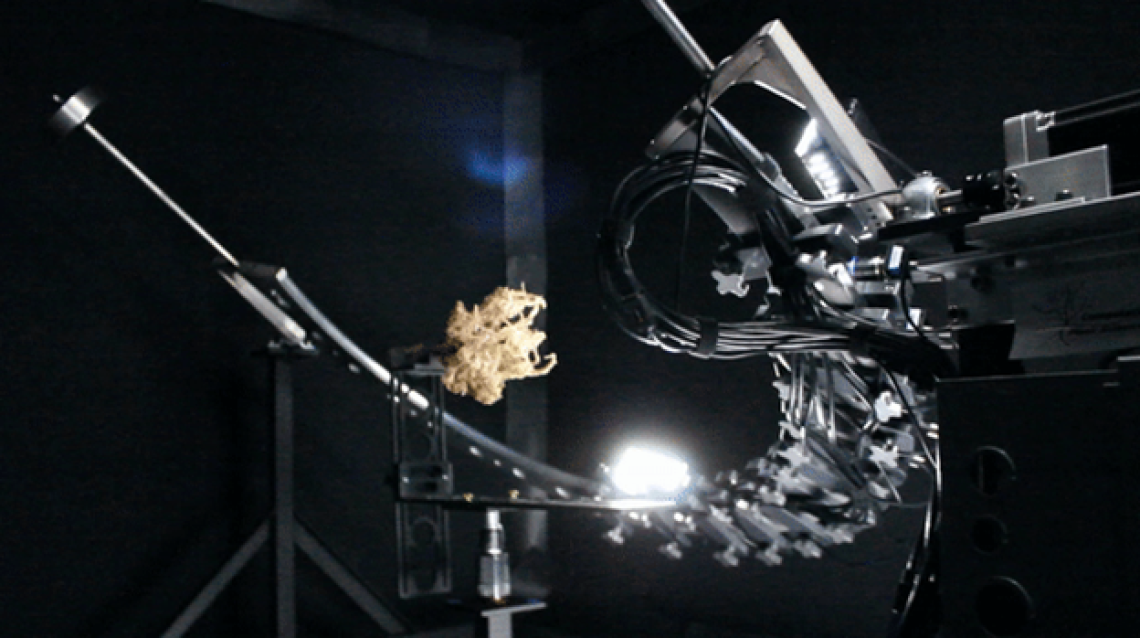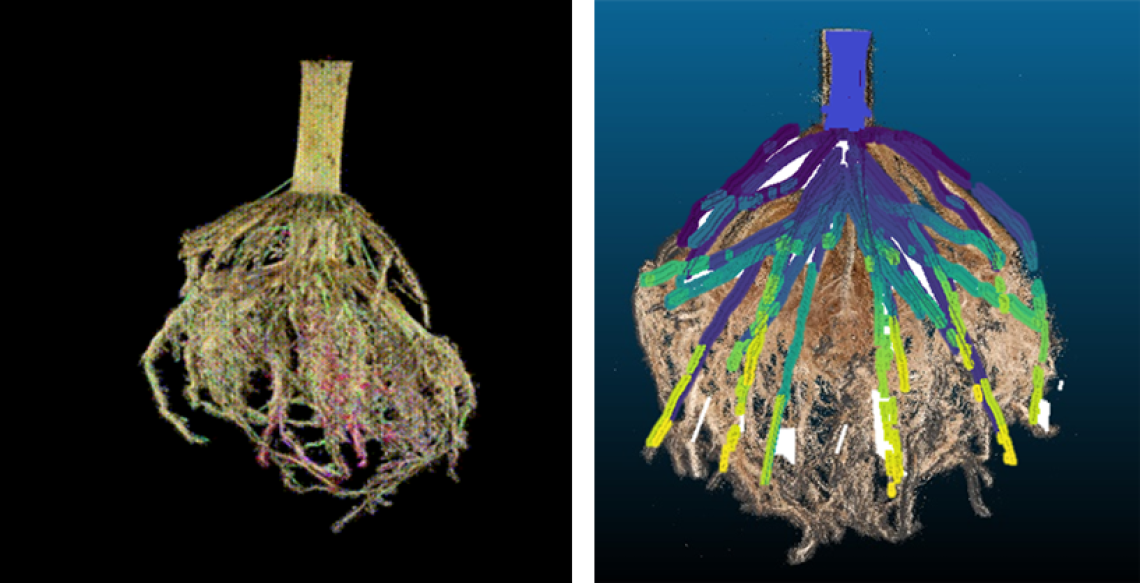CyVerse Gets to the Root of Research
Plant researcher found quick solutions to data storage and computing needs through CyVerse.

Alex Bucksch, an Associate Professor in the University of Arizona School of Plant Sciences, studies plant phenotypes and root phenomics from the molecular level to the population level. With global population and climate change concerns, Bucksch sees the need for addressing the increasing demand for agricultural products and climate models that consider specific plant morphologies to support human existence. To meet these demands, Bucksch believes it is vital to have an enhanced understanding of the facets of plant development and their subsequent phenotypes.

Left: Alex Bucksch. Right: Maize roots. (Credit: Alex Bucksch)
Bucksch utilizes the mathematical concept of "shape descriptors" in his study of plant science to understand the status and growth of complex structures. Through the use of imaging instruments and simulation models, he is able to capture the spatial arrangement of roots, branches, and other organs that comprise complex phenotypes and the underlying rules of their formation. He sees the significance in using imaging data to best comprehend how plants acclimatize or adapt to their environments. Through observing imaging data, it is possible to see the arrangement of plant organs that form the plant phenotype. Bucksch's methods have resulted in the detection of phenotypes that were not previously discovered by classically trained biologists.

3D scanner takes pictures of a plant root. (Credit: Alex Bucksch)
With the large amount of data produced from his research, Bucksch found the need for a way to store and utilize the vast project data. He found the solution in CyVerse, which he began to utilize in 2011. Bucksch said, "We are constantly producing data which needs to be stored somewhere, and we need a platform where we can compute this data without moving it around too much. We need the storage and computing abilities that CyVerse can provide."
The first project Bucksch did with CyVerse was called DIRT (Digital Imaging of Root Traits), which measured monocot and dicot root traits from digital images. The DIRT process facilitates the use of high-performance computing along with storage, organization, and sharing of image data. This project enabled the automation of the extraction of root traits by making a high-throughput grid computing environment available to those without technical training.
Bucksch explained, "We made a platform where people can upload imaging data and get all the relevant traits they need for their scientific investigations. DIRT became the largest root phenotyping platform in the world. Researchers can use the information generated from DIRT to do things like discovering genes that improve nutrient uptake. CyVerse provided numerous benefits, including the ease of collaboration. This is all big data driven work, not only by my research group, but also by many others with whom we share our tools. Therefore, this marketplace of data is very important.

Left: 3D image of a root. Right: Computer-generated image of a root. (Credit: Alex Bucksch)
Bucksch noted that two prominent collaborative studies used DIRT for their research. One involved researcher Hannah Schneider, of Wageningen University in the Netherlands, who discovered genes that regulate the rooting angle in plants and how the rooting angle contributes to the efficiency of nitrogen uptake. This research is important, as the development of crops with reduced water and nutrient requirements are vital to enhancing global agriculture.
Another researcher who used the DIRT platform was Dorota Kawa at UC Davis, who utilized DIRT to extract traits in order to locate genes that regulate root exudates, which are substances that are secreted by the roots of plants. Kawa discovered that with regulating these genes, it is possible to change the composition of the exudates and avoid triggering Striga production. Striga is a root parasitic weed that is responsible for reducing the sorghum crop yield in South Africa by approximately 20% annually. The suppression of Striga by microbiome-mediated mechanisms is important to improve Striga management practices and ultimately to increase sorghum crop yield in South Africa.
Bucksch noted that after almost 10 years of continuous operation, the original DIRT website will be retired this year. However, DIRT will live on as a part of the many workflows provided by its successor PlantIT. The extended platform was released at the 2022 conference of the North American Plant Phenotyping Network.
Bucksch found the ease of using CyVerse from any location to be another asset. Prior to joining the University of Arizona, Bucksch was an Associate Professor of Plant Biology at the University of Georgia, and while moving to Arizona he was able to use CyVerse from his car. Bucksch recalled, "Before I came to UA, I was already working with Duke Pauli (of the UA School of Plant Sciences) and his students. They have all their data in CyVerse and shared it with me, and I was computing everything with remote access during a quick stop at a gas station while moving from Georgia to Arizona. So I could collaborate and start computations and provide my collaborators with traits for their root data on the go. With the central repository CyVerse provides, it makes you very flexible and independent from a specific location."
"CyVerse enables so much more than just your individual project; it scales your project," Bucksch added. "I think that is the most important part. The ability to scale up my work to a community resource that goes all over the world was not previously possible for a single researcher. I was able to build my career based on CyVerse functions. Myself and many others wouldn't be in academia without CyVerse. I would never have made it into a plant sciences department and made this translation from my original background into plant biology without it. CyVerse is a community builder. It connects you with other people. That enables you to translate into other fields. It changes the field of academia."

